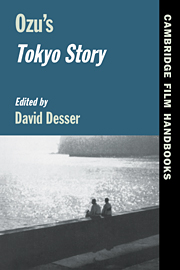Book contents
- Frontmatter
- Contents
- List of Contributors
- Introduction: A Filmmaker for All Seasons
- 1 Ozu's Tokyo Story and the “Recasting” of McCarey's Make Way for Tomorrow
- 2 Travel Toward and Away: Furusato and Journey in Tokyo Story
- 3 Ozu's Mother
- 4 Buddhism in Tokyo Story
- 5 Sunny Skies
- Filmography
- Reviews of “Tokyo Story”
- Select Bibliography
- Index
3 - Ozu's Mother
Published online by Cambridge University Press: 16 January 2010
- Frontmatter
- Contents
- List of Contributors
- Introduction: A Filmmaker for All Seasons
- 1 Ozu's Tokyo Story and the “Recasting” of McCarey's Make Way for Tomorrow
- 2 Travel Toward and Away: Furusato and Journey in Tokyo Story
- 3 Ozu's Mother
- 4 Buddhism in Tokyo Story
- 5 Sunny Skies
- Filmography
- Reviews of “Tokyo Story”
- Select Bibliography
- Index
Summary
Edo's culture was matriarchal, taking into its fold both good and bad sons. It was not a patriarchal culture that killed or drove away sons who weren't up to standard. It did not seek to attain purity through deductions and deletions. It continued to create something new through additions, mixture and blending. Now that the post–World War II period of singleminded modernization is over, the matriarchal, productive katagi [Zeitgeist, character] of Edo and early Tokyo seems to be stirring again.
(Yuichiro Kojiro, “Edo: The City on the Plain”)Tokyo Story is a quintessential city film, and cinema, as we know it, was born in the city. From the tiniest storefront peepshows to nickelodeon madness to the opulent picture palaces of the late 1920s, film exhibition was directed at concentrated masses of city dwellers clambering for admission to the latest attraction. Distributors devised the run-zone-clearance system to ensure the fullest saturation of densely populated districts before turning to exploit more diffuse markets farther out. The diffusion of institutional cinema originally showed a centrifugal pattern outward from the metropolis (first from New York and Culver cities, before Hollywood occupied the center of the firmament) and, later, the post–World War I targeting of foreign countries to draw them into an orbit of dependency on American product. This outward diffusion of urban amusement took place at a time when rural and village life could be counted as an important touchstone, perhaps even a norm, for American cultural values.
- Type
- Chapter
- Information
- Ozu's Tokyo Story , pp. 76 - 100Publisher: Cambridge University PressPrint publication year: 1997
- 1
- Cited by



